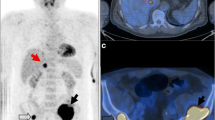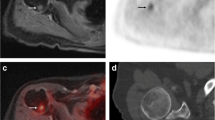Abstract
Objective
To determine the usefulness of FDG PET/CT scanning in the management and staging of myeloma and to assess its strengths and limitations.
Design
FDG PET/CT scans and all other available imaging studies were reviewed retrospectively from 16 consecutive patients by two experienced musculoskeletal radiologists and two nuclear medicine physicians working in consensus.
Patients
The 16 patients had undergone a total of 19 FDG PET/CT scans. Radiographs were available in all cases, including 13 skeletal surveys; 25 CT scans (16 chest, three abdominal, four pelvic, one spine, one neck) and 22 MR imaging studies (17 spine, three pelvic, two extremity) also were reviewed. Patients’ records were examined for relevant clinical information. All focal areas of abnormal FDG uptake were correlated with the other imaging studies to determine clinical significance. FDG PET/CT scans also were reviewed to see if small lesions shown on the other imaging studies could be identified in retrospect.
Results
The 12 men and four women had an average age of 58 years (range 30–69 years). All 16 patients had an established diagnosis of multiple myeloma, with average duration of disease, from time of initial diagnosis to review, of 30 months (range 6 months to 11+ years). The FDG PET/CT scans revealed a total of 104 sites (90 in bone, 14 soft tissue) that were suspicious for neoplastic activity based on a standardized uptake value (SUV) greater than 2.5. Fifty-seven of these sites (55%) were new or previously undetected. The other imaging studies (X-ray, CT, MR) and clinical information confirmed the other 47 areas but also revealed 133 other small skeletal lesions. Six of these 133 additional lesions showed mild FDG uptake on re-review of the PET/CT scans. The FDG PET/CT findings led to management changes in 9/16 patients. MR imaging revealed five cases of diffuse bone involvement (four spine, one scapula) that were not evident by FDG PET/CT.
Conclusion
FDG PET/CT scans are useful for the management and staging of myeloma. However, if PET/CT were the sole imaging study done, it would miss many additional small lytic skeletal lesions and could miss diffuse spine involvement.





Similar content being viewed by others
References
Dispenzieri A, Kyle RA. Multiple myeloma: clinical features and indications for therapy. Best Pract Res Clin Haematol 2005;18:553–568
Mulligan M. Imaging techniques used in the diagnosis, staging, and follow-up of patients with myeloma. Acta Radiol 2005;46:716–724
International Myeloma Working Group. Criteria for the classification of monoclonal gammopathies, multiple myeloma and related disorders: a report of the International Myeloma Working Group. Br J Haematol 2003;121:749–757
Durie B, Kyle R, Belch A, et al. Myeloma management guidelines: a consensus report from the Scientific Advisors of the International Myeloma Foundation. Hematol J 2003;4:379–398
Durie B. Salmon S. A clinical staging system for multiple myeloma. Cancer 1975;36:842–854
Bredella MA, Steinbach L, Caputo G, Segall G, Hawkins R. Value of FDG PET in the assessment of patients with multiple myeloma. AJR Am J Roentgenol 2005;184:1199–1204
Mileshkin L, Blum R, Seymour JF, Patrikeos A, Hicks RJ, Prince HM. A comparison of fluorine-18 fluoro-deoxyglucose PET and technetium-99 m sestamibi in assessing patients with multiple myeloma. Eur J Haematol 2004;72:32–37
Durie BGM, Waxman AD, D’Agnolo A, Williams CM. Whole-body 18F-FDG PET identifies high-risk myeloma. J Nucl Med 2002;43:1457–1463
Jadvar H, Conti PS. Diagnostic utility of FDG PET in multiple myeloma. Skeletal Radiol 2003;31:690–694
Mendenhall WM, Mendenhall CM, Mendenhall NP. Solitary plasmacytoma of bone and soft tissue. Am J Otolaryngol 2003;24:395–399
Greipp PR, San Miguel J, Durie BGM, et al. International staging system for multiple myeloma. J Clin Oncol 2005;23:3412–3420
Lecouvet F, Dechambre S, Malghem J, Ferrant A, Vande Berg B, Maldague B. Bone marrow transplantation in patients with multiple myeloma: prognostic significance of MR imaging. AJR Am J Roentgenol 2001;176:91–96
Lecouvet F, De Nayer P, Garbar C, et al. Treated plasma cell lesions of bone with MRI signs of response to treatment: unexpected pathological findings. Skeletal Radiol 1998;27:692–695
Author information
Authors and Affiliations
Corresponding author
Rights and permissions
About this article
Cite this article
Breyer, R.J., Mulligan, M.E., Smith, S.E. et al. Comparison of imaging with FDG PET/CT with other imaging modalities in myeloma. Skeletal Radiol 35, 632–640 (2006). https://doi.org/10.1007/s00256-006-0127-z
Received:
Revised:
Accepted:
Published:
Issue Date:
DOI: https://doi.org/10.1007/s00256-006-0127-z




